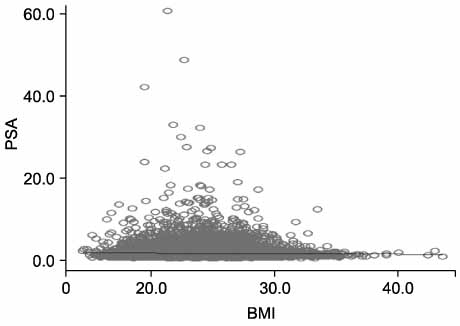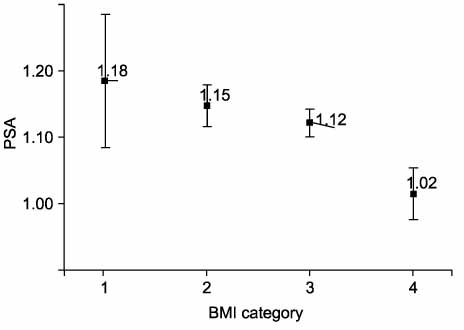Korean J Urol.
2007 Nov;48(11):1121-1124. 10.4111/kju.2007.48.11.1121.
The Association of Body Mass Index and Prostate-Specific Antigen
- Affiliations
-
- 1Department of Urology, Keimyung University School of Medicine, Daegu, Korea. cikim@dsmc.or.kr
- KMID: 1997087
- DOI: http://doi.org/10.4111/kju.2007.48.11.1121
Abstract
-
PURPOSE: Recent studies have reported the association of obesity and advanced stage prostate cancer. We researched the association between body mass index(BMI), which is widely used to diagnose obesity, and the prostate-specific antigen(PSA) screening test for prostate cancer.
METERIALS AND METHODS: The authors examined the association between BMI and PSA for 26,193 men who visited the health promotion center at our medical center from July 1998 to June 2004. The BMI(weight in kg/height in m2) was calculated from the measured height and weight and this was categorized as follows: BMI<18.5(underweight), BMI 18.5-23.0(normal weight), BMI 23.0-27.5(overweight), BMI>27.5(obesity). We measured the mean PSA value of each BMI category. After adjust for age, we evaluated the PSA according to BMI by using error bars and 95% confidence intervals.
RESULTS
The patients' age distribution was from 20 to 90 years old and their mean age was 46.1. The mean PSA value increased in a linear fashion with an increase in the age category(p<0.001), while it decreased in a linear fashion with an increase in the BMI category(p<0.001). After adjusting for age, the mean PSA value also decreased in a linear fashion with an increase in the BMI category(p<0.001).
CONCLUSIONS
Men with an elevated BMI tend to have a lower value of PSA and to be misdiagnosed with prostate cancer. The PSA value should considered in relation to age and the BMI for the early detection of prostate cancer.
Keyword
MeSH Terms
Figure
Cited by 2 articles
-
Factors Influencing the Prostate-specific Antigen Levels after Adjusting Age and Prostate Volume in Korean Men
Jae I Koh, Won Jae Yang, Yun Seob Song, Young Ho Park
Korean J Urol. 2008;49(5):411-417. doi: 10.4111/kju.2008.49.5.411.Metabolic Syndrome and Benign Prostatic Hyperplasia: A Study Focused on the Correlation between Metabolic Syndrome Factors and Prostate Volume and Prostate-specific Antigen
Taek Hwan Jang, Jeong Hwan Son, Jae Il Kim, Seok Heun Jang
Korean J Urol. 2008;49(11):986-991. doi: 10.4111/kju.2008.49.11.986.
Reference
-
1. Allison DB, Fontaine KR, Manson JE, Stevens J, VanItallie TB. Annual deaths attributable to obesity in the United States. JAMA. 1999. 282:1530–1538.2. Freedland SJ, Aronson WJ, Kane CJ, Presti JC Jr, Amling CL, Elashoff D, et al. Impact of obesity on biochemical control after radical prostatectomy for clinically localized prostate cancer: a report by the Shared Equal Access Regional Cancer Hospital database study group. J Clin Oncol. 2004. 22:446–453.3. Rohrmann S, Roberts WW, Walsh PC, Platz EA. Family history of prostate cancer and obesity in relation to high-grade disease and extraprostatic extension in young men with prostate cancer. Prostate. 2003. 55:140–146.4. Freedland SJ, Platz EA, Presti JC Jr, Aronson WJ, Amling CL, Kane CJ, et al. Obesity, serum prostate specific antigen and prostate size: implications for prostate cancer detection. J Urol. 2006. 175:500–504.5. Baillargeon J, Pollock BH, Kristal AR, Bradshaw P, Hernandez J, Basler J, et al. The association of body mass index and prostate-specific antigen in a population-based study. Cancer. 2005. 103:1092–1095.6. Thompson IM, Leach R, Troyer D, Pollock B, Naylor S, Higgins B. Relationship of body mass index and prostate specific antigen in a population-based study. Urol Oncol. 2004. 22:127–131.7. Ahn JO, Ku JH. Relationship between serum prostate-specific antigen levels and body mass index in healthy younger men. Urology. 2006. 68:570–574.8. Fowke J, Signorello L, Chang S. Effects of obesity and height on prostate-specific antigen (PSA) and percentage of free PSA levels among african-american and cucasian men. Cancer. 2006. 107:2361–2367.9. Kristal AR, Chi C, Tangen CM, Goodman PJ, Etzioni R, Thompson IM. Associations of demographic and lifestyle characteristics with prostate-specific antigen (PSA) concentration and rate of PSA increase. Cancer. 2006. 106:320–328.10. Werny DM, Thompson T, Saraiya M, Freedman D, Kottiri BJ, German RR, et al. Obesity is negatively associated with prostate-specific antigen in U.S. men, 2001-2004. Cancer Epidemiol Biomarkers Prev. 2007. 16:70–76.11. WHO Expert Consultation. Appropriate body-mass index for Asian populations and its implications for policy and intervention strategies. Lancet. 2004. 363:157–163.12. Bray GA. The underlying basis for obesity: relationship to cancer. J Nutr. 2002. 132:Suppl. 3451S–3455S.13. Amling CL, Kane CJ, Riffenburgh RH, Ward JF, Roberts JL, Lane RS, et al. Relationship between obesity and race in predicting adverse pathologic variables in patients undergoing radical prostatectomy. Urology. 2001. 58:723–728.14. Ku JH, Kim ME, Lee NK, Park YH, Ahn JO. Influence of age, anthropometry, and hepatic and renal function on serum prostate-specific antigen levels in healthy middle-age men. Urology. 2003. 61:132–136.15. Ku JH, Jeon YS, Kim ME, Lee NK, Park YH, Ahn JO. Influence of age, rate of obesity, hepatic function and renal function on serum prostate-specific antigen in men older than 50 years. Korean J Urol. 2001. 42:1284–1290.16. Dahle SE, Chokkalingam AP, Gao YT, Deng J, Stanczyk FZ, Hsing AW. Body size and serum levels of insulin and leptin in relation to the risk of benign prostatic hyperplasia. J Urol. 2002. 168:599–604.17. Eldrup E, Lindholm J, Winkel P. Plasma sex hormones and ischemic heart disease. Clin Biochem. 1987. 20:105–112.18. Barqawi AB, Golden BK, O'Donnell C, Brawer MK, Crawford ED. Observed effect of age and body mass index on total and complexed PSA: analysis from a national screening program. Urology. 2005. 65:708–712.19. Kang SG, Yoon CY, Yoon DK. Obesity is an independent predictor of biochemical failure following radical prostatectomy and androgen deprivation therapy (ADT) for prostate cancer. Korean J Urol. 2005. 46:1262–1267.
- Full Text Links
- Actions
-
Cited
- CITED
-
- Close
- Share
- Similar articles
-
- In Search of a New Prostate-Specific Antigen
- The Factors Influencing the Percentage of Free Serum Prostate Specific Antigen Levels in Men without Clinically Detectable Prostate Cance
- The Diagnostic Value of Prostate-specific Antigen and the of Routine Laboratory Examination for Early Detection
- Association of Body Mass Index and Waist Circumference with Prostate-Specific Antigen
- Change of serum prostate specific antigen values after radiation therapy in prostate cancer



